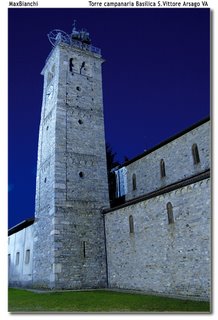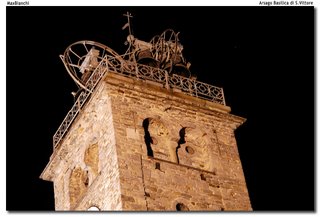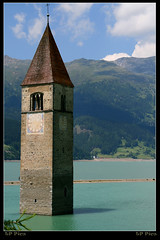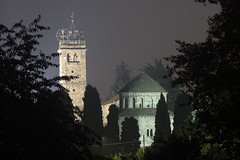 The more solemn memory of the ancient one protopieve. Rebuilt on the primitive construction of the fifth century, it has navate a rectangular system and it is uniform in three with the respective apses to east. The external building vestment is constituted from stones not squared; the uniformità of the walls is interrupted from the windows to round arc and from one wrap of blind bows which I ornament. To the inside the ceiling is in truss wood , arched that they divide the navate ones alternatively are supported from the massive pillars to square plant and exiles columns, nearly all Roman of recovery. The apse centers receives them the constructed eighteen century marble altar on design of painter Biagio Bellotti.
The more solemn memory of the ancient one protopieve. Rebuilt on the primitive construction of the fifth century, it has navate a rectangular system and it is uniform in three with the respective apses to east. The external building vestment is constituted from stones not squared; the uniformità of the walls is interrupted from the windows to round arc and from one wrap of blind bows which I ornament. To the inside the ceiling is in truss wood , arched that they divide the navate ones alternatively are supported from the massive pillars to square plant and exiles columns, nearly all Roman of recovery. The apse centers receives them the constructed eighteen century marble altar on design of painter Biagio Bellotti.
E' il ricordo più solenne dell’antica protopieve. Riedificata sulla primitiva costruzione del quinto secolo, ha un impianto rettangolare ed è divisa in tre navate con le rispettive absidi ad oriente. Il paramento murario esterno è costituito da pietre non squadrate; l’uniformità delle pareti è interrotta dalle finestre ad arco tondo e da una fascia di archetti ciechi quale ornamento. All'interno il soffitto è in legno a capriate, le arcate che dividono le navate sono alternativamente sostenute da massicci pilastri a pianta quadrata e da esili colonne, quasi tutte romane di recupero. L'abside centrale accoglie l'altare marmoreo settecentesco costruito su disegno del pittore Biagio Bellotti.
 The bell tower is raised that, constructed in XII the century with coming from materials from ancient buildings, introduces the noble stone insertion of roman age. The walls are diveded in shelves from frames decorated with sourmounted hanging bows from frieze to tooth of saw. The bell cell is characterized from four double lancet windows with capital adorns, it maintained its appearance to you until to 1872 when the bells came placed uncovered on the terrace upstairs.
The bell tower is raised that, constructed in XII the century with coming from materials from ancient buildings, introduces the noble stone insertion of roman age. The walls are diveded in shelves from frames decorated with sourmounted hanging bows from frieze to tooth of saw. The bell cell is characterized from four double lancet windows with capital adorns, it maintained its appearance to you until to 1872 when the bells came placed uncovered on the terrace upstairs.A ridosso si innalza la torre campanaria che, costruita nel XII secolo con materiali provenienti da antichi edifici, presenta l'inserimento di pietre nobili di età romana. Le pareti sono divise in ripiani da cornici decorate con archetti pensili sormontati da fregi a dente di sega. La cella campanaria è caratterizzata da quattro bifore con capitelli ornati, essa mantenne la sua fisionomia fino al 1872 quando le campane vennero collocate allo scoperto su un terrazzo soprastante.
S. Vittore's basilica and S. Giovanni Battista's baptistry.
They was built around the IX and XII century.




No comments:
Post a Comment